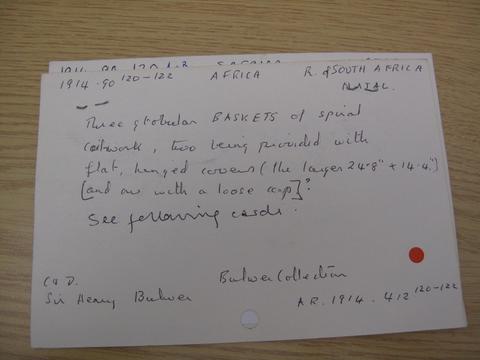Title and statement of responsibility area
Titel
MAA catalogue card E 1914.90.121 (01)
Algemene aanduiding van het materiaal
- Tekst document
Parallelle titel
Overige titelinformatie
Title statements of responsibility
Titel aantekeningen
- Source of title proper: Rachel Hand for MAA
Beschrijvingsniveau
Stuk
archiefbewaarplaats
referentie code
Editie
Editie
Edition statement of responsibility
Class of material specific details area
Statement of scale (cartographic)
Statement of projection (cartographic)
Statement of coordinates (cartographic)
Statement of scale (architectural)
Issuing jurisdiction and denomination (philatelic)
Datering archiefvorming
Datum(s)
-
2016 - (Online curation)
-
YYYY (Making)
Fysieke beschrijving
Fysieke beschrijving
Publisher's series area
Title proper of publisher's series
Parallel titles of publisher's series
Other title information of publisher's series
Statement of responsibility relating to publisher's series
Numbering within publisher's series
Note on publisher's series
Archivistische beschrijving
Geschiedenis beheer
[Source - Rachel Hand for MAA, 2016: The Museum’s catalogue cards and labels are part of the institution' and the objects' very history. Catalogue cards were created to add additional object information from the very first accessions back in 1884 and replacement cards were made if the original was lost, usually using both different pens and terms. Original sale or collector labels could be stuck to the cards to add biographical layers of information in the same way that letters and later photographs were sometimes attached to cards. Staff and sometimes visitors would add comments on provenances, measurements and locations over time. Reconnecting an author with their annotations can add to our knowledge of the object’s history and associations. The era and author of the cards also is reflected in their physical aspects: initially details were handwritten in ink, the 1930s saw cards stamped and written on a typewriter, followed variously by handwritten details in ballpoint pen, finally moving to word-processed and laser printed texts.
Like the cards the physical type of paper and pen used can suggest dates as well as authors. They can be used to confirm the identity of misplaced objects, e.g. Henry Bulwer’s collection bears distinctive long, rectangular shaped paper labels and his cursive script.
Early labels were handwritten in ink, on small rectangular paper or parchment label and tied through small metal reinforced holes. Others were glued directly to the object. Smaller rectangular or square paper labels, with a printed outline, usually stuck directly to the object, usually originate in late nineteenth or early twentieth century salerooms or via a collector. Larger circular, metal-edged labels were written in the museum, probably from the 1970s onwards. The 1980s bought larger labels on thick yellow paper, and remained handwritten. From c.2000, we have used acid-free yellowish paper labels, that are written on in light-sensitive and waterproof ink.]
Bereik en inhoud
Aantekeningen
Materiële staat
Directe bron van verwerving
Ordening
Taal van het materiaal
Schrift van het materiaal
Plaats van originelen
Beschikbaarheid in andere opslagformaten
Restrictions on access
Termen voor gebruik, reproductie en publicatie.
Creative Commons License: CC BY-NC-ND
https://creativecommons.org/licenses/by-nc-nd/3.0/
Unless otherwise stated the copyright of all material on the FHYA resides with the contributing institution/custodian.
Toegangen
Associated materials
Aanvullingen
Algemene aantekening
Additional title information
[Source - Nessa Leibhammer for FHYA using MAA materials, 2012: General Card for 1914.90.1 - 154: NB The Bulwer Collection of 1912 was found to be slightly confused when it was sorted out. The objects found marked "Bulwer Collection 1912" did not always tally with the description in the Annual Report. Some objects did not appear on the list at all - these have been added to the Z Register (created by the Museum’s second curator, Louis Clarke, instigated in January 1923) and as far as possible their numbers appear overleaf. All cards marked Bulwer Collection were taken out and were given the new appropriate numbers, but it was found that often there were many more of a certain kind of object than mentioned in the list. Where this has happened I have altered the original description in the accession book and on the cards in order to try to fit these in, rather than picking certain objects at random to be added to the Z Register, since apparently objects given by Bulwer filtered in at various times over the years, especially after his death, but were not recorded. Since all the objects were Zulu, I think its best to keep them together. (Note found in accession register, written by Kay Holman) - MAA (01/12/1998)]



Material contributed by members of the public
Building an archive is a collective endeavour. Please help us grow the FHYA knowledge base.
If you want to add information to this page you can insert a hyperlink, add files and/or text to the box below.
In the case of material relevant to the FHYA as a whole please upload information HERE.
The FHYA does not vet this material but reserves the right to remove anything deemed to be racist, homophobic, sexist or otherwise offensive. Everything on the FHYA is licensed under a Creative Commons CC BY-NC-ND licence.
To make a contribution you must be a registered user. To register an account, click here. Note that after registration you will not be automatically redirected to this page.
If you have already registered but are not logged in, log in here.